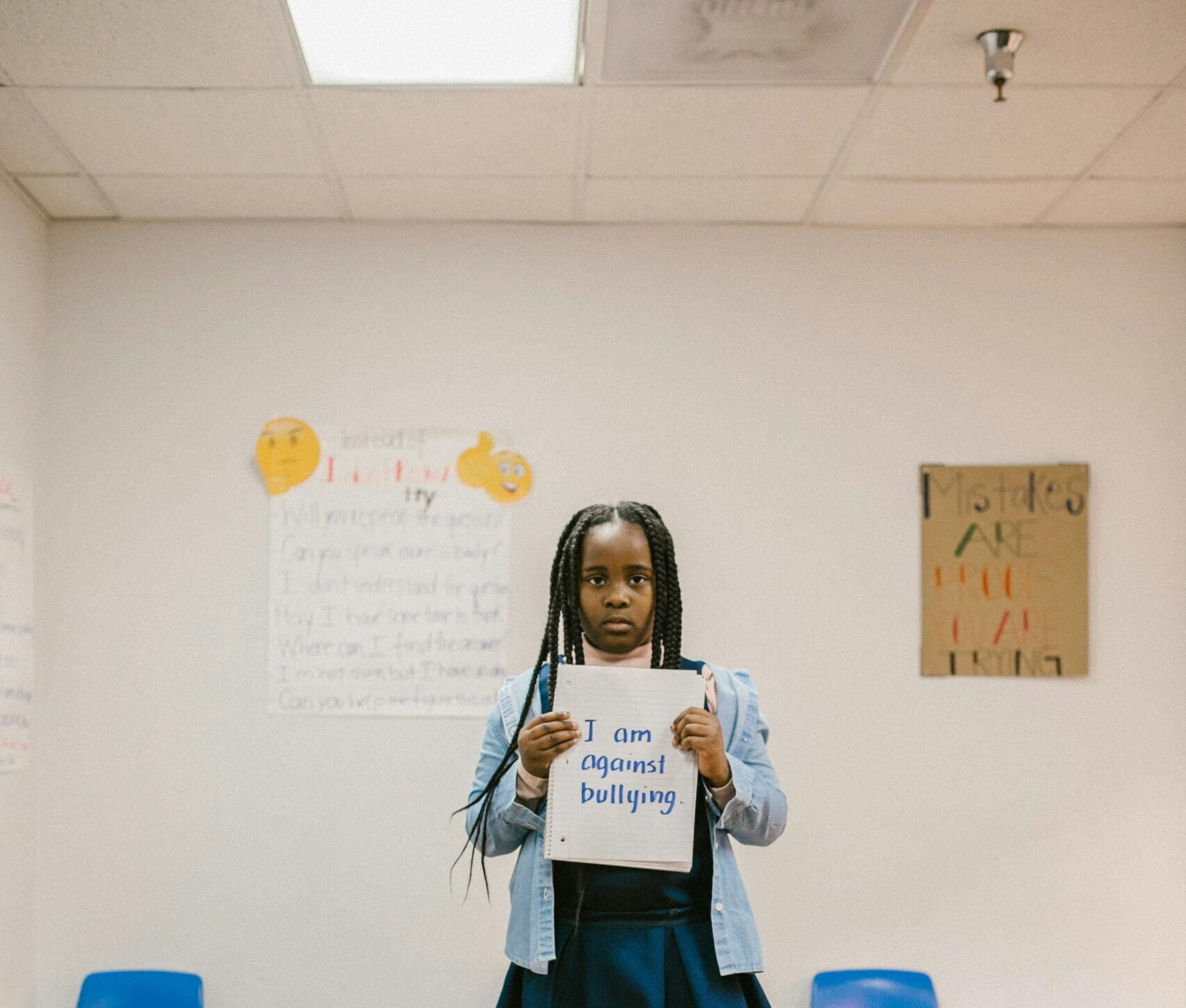Imagine taking a walk in school, feeling like everyone’s staring and whispering about you. Or you’re at home, seeing mean messages pop up on your phone screen. That sinking feeling? That’s bullying, and it’s a big problem that hurts a lot of people, not just on the playground or in school, but online too. It can make you feel alone, scared, and really sad.
Bullying comes in many forms. Sometimes it’s someone pushing you around or hitting you. Other times, it’s someone teasing, making fun of you, or calling you names. It can even be someone spreading rumors or leaving you out on purpose to make you feel bad. And then there’s cyberbullying, where people use the internet to say mean things where everyone can see.
You might think, “It’s just kids being kids,” but it’s a lot more serious than that. When someone gets bullied, it doesn’t just hurt their feelings. It can make them feel anxious and depressed, not want to go to school, and even make them sick. The worry and sadness can stick around for a long time, even when they’re grown up.
In this article, we’re going to talk all about bullying – what it looks like, how it feels, and the different ways it happens.
Defining Bullying and Its Forms
Bullying happens between someone who has more power and is more aggressive than their targeted person. A bully uses that power—whether it’s physical strength, being more popular, or knowing embarrassing information—to hurt or control the person they’re bullying.
The person who is being bullied may find it hard to defend themselves and may feel increasingly powerless against the person bullying them.
Physical Bullying
This is is one of the most visible forms, involving direct physical contact that causes harm or discomfort to the victim. This can include hitting, kicking, pushing, tripping, or any form of unwanted physical aggression. Physical bullying also extends to the damage or theft of a victim’s property, which serves to intimidate and exert control. Despite being the most noticeable, it’s often just the tip of the iceberg, with deeper psychological impacts lying beneath the surface.
Verbal Bullying
Verbal bullying uses words to cause harm. This includes taunting, teasing, insulting, name-calling, and making threatening or derogatory remarks. Unlike physical bullying, verbal bullying can be harder to detect, as it doesn’t leave visible marks. However, the emotional scars can be profound, affecting the victim’s self-esteem and sense of security. It can occur in person or through digital platforms, where words can be amplified and remain permanently accessible.
Social or Relational Bullying
This form of bullying aims to manipulate others’ social standing and relationships. Tactics include spreading rumors, intentional exclusion (social ostracism), public embarrassment, and turning peers against the victim. It can be particularly damaging to the victim’s social networks and self-esteem, leading to isolation and loneliness. Because it operates within the complex dynamics of social groups, relational bullying can be challenging to recognize and address.
Cyberbullying
Although the internet can benefit a child’s academic growth and development, it also makes them more vulnerable to cyberbullying. This form involves using social media, text messages, emails, and other digital platforms to harass, threaten, or embarrass someone. Unique to cyberbullying is its pervasive nature; victims can be reached at any time and place, and the bullying content can be distributed widely with relative anonymity.
According to one study published by JAMA, young people exposed to cyberbullying are at a 50% increased risk of suicidal thoughts than their peers. Another recent study showed that children and young adults who experience cyberbullying are more than twice as likely to harm themselves and display suicidal behavior.
One study published by the Joint Research Center found that more than half of all children surveyed had experienced cyberbullying in some way.
The Effects of Bullying on Mental Health
Bullying can affect mental, physical and emotional health during school years and into adulthood. It can lead to physical injury, social or emotional problems and in some cases, even death. However, the immediate effects include:
- Anxiety and Stress: Victims of bullying often experience heightened levels of anxiety and stress. The constant fear of being bullied again can lead to a state of hyperarousal, where the individual remains on high alert for potential threats. This state of chronic stress can disrupt sleep, impair concentration, and lead to avoidance behaviors, severely impacting daily functioning and academic performance.
- Depression: The relentless nature of bullying can lead to feelings of sadness, hopelessness, and a profound sense of isolation. Victims might internalize the negative messages received from bullies, leading to a decrease in self-esteem and self-worth. Over time, these feelings can intensify, potentially developing into clinical depression, characterized by persistent sadness, loss of interest in previously enjoyed activities, and significant changes in appetite and sleep patterns.
- Self-esteem and Isolation: Bullying attacks the very sense of self of the victim, eroding their self-esteem and contributing to a distorted self-image. The shame and stigma associated with being bullied often discourage victims from seeking help or connecting with peers, leading to social withdrawal and isolation. This isolation further exacerbates feelings of loneliness and unworthiness, creating a vicious cycle that can be difficult to break.
Long-term Psychological Effects
- Post-Traumatic Stress Disorder (PTSD): For some individuals, the experience of being bullied can lead to PTSD, especially if the bullying was particularly severe or prolonged. Symptoms of PTSD include flashbacks, nightmares, severe anxiety, and uncontrollable thoughts about the bullying incident(s). Victims may go to great lengths to avoid reminders of the trauma, significantly limiting their ability to function and engage with the world around them.
- Increased Risk of Suicidal Thoughts and Behaviors: The link between bullying and suicidal thoughts and behaviors is well-documented. The accumulation of psychological distress, including depression, anxiety, and a sense of hopelessness, can lead some victims to contemplate or attempt suicide. The risk is particularly high among those who feel they have no escape or support system to turn to.
- Long-lasting Emotional Impact: The emotional scars left by bullying can persist well into adulthood, influencing an individual’s ability to form healthy relationships, trust others, and maintain a positive self-image. Adults who were bullied as children may exhibit higher levels of anxiety, depression, and other mental health issues compared to those who were not bullied. They may also have a heightened sensitivity to criticism and a fear of rejection, affecting their personal and professional relationships.
How to Help Someone Affected by Bullying
Helping someone affected by bullying is a critical step in healing the wounds it causes. Whether you’re a friend, family member, educator, or bystander, your support can make a profound difference in the life of someone who’s being bullied. Here’s how you can help:
- Listen Without Judgment: Start by offering a compassionate ear. Let the person know you’re there to listen without judging them or their situation. Being heard can be a powerful first step in healing, providing the victim with a sense of safety and understanding. Listening also helps you grasp the extent of the bullying and its impact, which is essential for providing the right kind of support.
- Offer Reassurance and Validation: Victims of bullying often feel isolated, ashamed, and misunderstood. It’s crucial to reassure them that the bullying is not their fault and that their feelings are valid and understandable. Emphasize that everyone deserves to be treated with respect and kindness, and remind them of their strengths and worth.
- Encourage Them to Seek Help: Many bullying victims may feel helpless or fearful of making the situation worse by speaking out. Encourage them to report the bullying to someone who can take action, like a teacher, school counselor, or a trusted adult. Assure them that seeking help is not a sign of weakness but a brave step towards stopping the bullying.
- Develop a Safety Plan: Work together to develop a safety plan. This might include identifying safe places to go if they feel threatened, people they can quickly reach out to for immediate support, and ways to avoid risky situations. Having a plan can help reduce anxiety and provide a sense of control.
- Boost Their Self-Confidence: Bullying can severely damage a person’s self-esteem. Help them rebuild their confidence by encouraging them to engage in activities they enjoy and are good at. Celebrate their successes and strengths, no matter how small, to help shift their focus from victimization to empowerment.
- Encourage Social Connections: Isolation is a common tactic used in bullying. Encourage the person to connect with friends and engage in social activities. Being part of a group or community can provide emotional support and reduce feelings of loneliness and isolation.
The battle against bullying is not fought on distant shores—it happens in our schools, our communities, and our homes. It’s in the words we choose, the behaviors we model, and the values we instill in the next generation. Our collective action can transform environments, making them safer and more inclusive for everyone.


